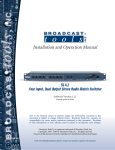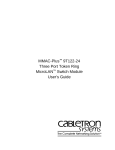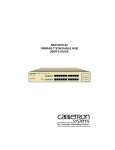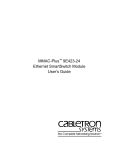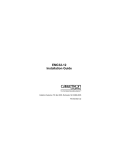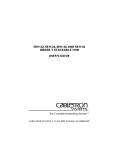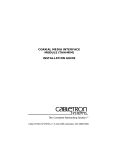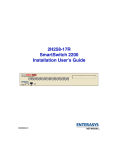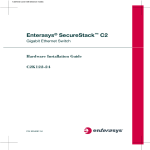Download Cabletron Systems FOT-DF24 User's Manual
Transcript
Transmit (XMT) This green LED flashes when the FOT-DF24 transmits data. The LED flash is pulse stretched for viewing effect. The XMT LED is off when the device is active but not transmitting. Receive (RCV) This yellow LED flashes when the FOT-DF24 receives data from the network. If attached to a repeater, RCV flashes when data passes through the FOT-DF24. The LED is pulse-stretched for viewing effect. Collision (CLN) This red LED flashes when the transceiver detects a collision condition or a jabber packet on the network. The flash frequency may increase as network traffic increases since more collisions are likely to occur. The LED is pulsestretched for viewing effect. Link OK (LNK) When lit, this green LED indicates that a link exists between the FOT-DF24 and the device at the other end of the fiber optic segment. LNK remains lit as long as the link is maintained. To maintain the link, the transceiver generates a 1 MHz idle signal when it is not transmitting data. Both ports can show a valid link. Active Port (ACT) This yellow LED indicates which fiber optic port is handling all network traffic through the transceiver. Only one port can be active; the inactive port ACT LED is off. A flashing ACT LED indicates that the port is in the idle state. A slow flash indicates that the time-out period is set to 10 seconds; a fast flash indicates that the time-out period is set to 2 seconds. GETTING HELP If you have questions, or need additional help, contact Cabletron Systems Technical Support as follows: By phone: Monday through Friday, 8 am to 8 pm EST at (603) 332-9400 By CompuServe: GO CTRON from any ! prompt By Internet mail: [email protected] LANVIEW is a registered trademark of Cabletron Systems, Inc. FOT-DF24 is a trademark of Cabletron Systems, Inc. CompuServe is a registered trademark of CompuServe, Inc. Ethernet is a trademark of Xerox Corp. FCC NOTICE This device complies with Par t 15 of the FCC rules. Operation is subject to the following two conditions: (1) this device may not cause harmful interference, and (2) this device must accept any interference received, including interference that may cause undesired operation. NOTE: This equipment has been tested and found to comply with the limits for a Class A digital device, pursuant to Part 15 of the FCC rules. These limits are designed to provide reasonable protection against harmful interference when the equipment is operated in a commercial environment. This equipment uses, generates, and can radiate radio frequency energy and if not installed in accordance with the operator’s m a n u a l , m ay c a u s e h a r m f u l i n t e r fe r e n c e t o r a d i o communications. Operation of this equipment in a residential area is likely to cause interference in which case the user will be required to correct the interference at his own expense. WARNING: Changes or modifications made to this device which are not expressly approved by the party responsible for compliance could void the user’s authority to operate the equipment. FOT-DF24 802.3 10BASE-FL/FOIRL Redundant Transceiver The FOT-DF24™ fiber optic transceiver is designed to link two Ethernet™ devices through fiber optic cable. Dual fiber optic ports with ST type connectors provide redundant data paths for critical applications. DOC NOTICE This digital apparatus does not exceed the Class A limits for radio noise emissions from digital apparatus set out in the Radio Interference Regulations of the Canadian Department of Communications. Primary Port FOT-DF24 SQE P W R 802.3 10BASE-FL/FOIRL REDUNDANT TRANSCEIVER WITH LANVIEW® 1 S Q E X R M V T C C L N LNK TX ACT RX LNK TX ACT RX SN NOTICE Cabletron Systems reserves the right to make changes in specifications and other information contained in this document without prior notice. The reader should in all cases consult Cabletron Systems to determine whether any such changes have been made. The hardware, firmware, or software described in this manual is subject to change without notice. IN NO EVENT SHALL CABLETRON SYSTEMS BE LIABLE F O R A N Y I N C I D E N TA L , I N D I R E C T, S P E C I A L , O R C O N S E Q U E N T I A L DA M AG E S W H AT S O E V E R (INCLUDING, BUT NOT LIMITED TO, LOST PROFITS) ARISING OUT OF OR RELATED TO THIS MANUAL OR T H E I N F O R M AT I O N C O N TA I N E D I N I T, E V E N I F CABLETRON SYSTEMS HAS BEEN ADVISED OF, KNOWN OR SHOULD HAVE KNOWN, THE POSSIBILITY OF SUCH DAMAGES. © Copyright August 1994 by Cabletron Systems, Inc. P.O. Box 5005, Rochester, NH 03866-5005 All Rights Reserved Printed in the United States of America Part number: 9030729-02 August 1994 2 MIN MAX Back-up Port If the primary port (port 1) receives no data for either 2 or 10 seconds (switch selectable), the port enters the idle state. During the idle state, if the back-up port (port 2) receives data it becomes the active port. When the primary port senses data again, it switches back to become the active port. The two transceiver ports can be connected to the same network device, different network devices or even different networks. REQUIREMENTS The FOT-DF24 Transceiver complies with IEEE 802.3 10BASE-FL/FOIRL specifications. Use the FOT-DF24 with Version 1, Version 2, and/or IEEE 802.3 equipment. For best network performance, observe the following network guidelines. Fiber Optic Requirements The FOT-DF24 supports 50/125 µm, 62.5/125 µm, and 100/140 µm fiber optic cable. Link length depends on cable type and system fiber optic budget. The FOTDF24 supports a maximum link length of 2 km. AUI Cable The AUI port connects the Transceiver to an Ethernet device. The cable can be up to 50 meters long and must comply with IEEE 802.3 or with Ethernet Version 1 or 2 specifications. Fiber Optic Cable Link Attenuation At an 850 nm wave length, link segment attenuation can be no more than: • 13.0 db for 50/125 µm cable • 16.0 db for 62.5/125 µm cable • 19.0 db for 100/140 µm cable OPERATING SPECIFICATIONS Cabletron Systems reserves the right to change these specifications any time without notice. General Receive Sensitivity: -29.5 dBm Max. Receive Power: -8.2 dBm Bit Error Rate: Better than 10-9 error rate Transmitter Peak Wavelength: 820 nm typical; 790 nm min; 860 nm max Spectral Width: 75 nm max Rise Time: 10 nsec max Fall Time: 10 nsec max Transmitter Power Into 50/125 µm fiber: -13.0 dBm ; -16.5 dBm worst case budget Into 62.5/125 µm fiber: -10.0 dBm ; 19.5 dBm worst case budget Into 100/140 µm fiber: -7.0 dBm; 22.5 dBm worst case budget Note: The transmitter power and receive sensitivity levels are peak power levels. To convert to average power levels, subtract 3 dbm. Power Supply Input Current: 500mA Input Voltage: 12.0 Vdc typical; 9.5 Vdc min; 15.75 Vdc max AUI 15 Pin D-Type Connector 8 Logic Ref 7 No Connection 6 Power Return 5 Receive + 4 Logic Ref. 3 Transmit + 2 Collision + 1 Logic Ref. O O O O O O O O O O O O O O O 15 No Connection 14 Logic Ref. 13 Power (+12Vdc) 12 Receive 11 Logic Ref. 10 Transmit 9 Collision - OPERATING ENVIRONMENT Operating Range: 5˚ to 40˚C (41˚ to 104˚ F) Heat Output: 17 Btu/hr Storage Range: -30˚ to 80˚C (-22˚ to 160˚F) Humidity Range: 5 to 95% (non-condensing) SAFETY Designed in accordance with UL 1950, CSA C22.2 No. 950, and EN 60950; the EMI requirements of FCC Class A and EN 55022 Class A; and the EMC requirements of EN 50082-1. Note: It is the responsibility of the person who sells the system to which the FOT-DF24 will be a part to ensure that the total system meets allowed limits of conducted and radiated emissions. INSTALLING THE FOT-FB24 To install your FOT-DF24, set the SQE and MIN/MAX switches, connect the AUI cable to an Ethernet device, connect the fiber optic ports to the network and use the cable ties and mounts to provide cable strain relief. Observe the requirements listed previously in this guide and the guidelines listed in the following sections. Setting the SQE Switch The SQE (Signal Quality Error) switch is a two position switch on the top of the transceiver. The FOT-DF24 is shipped with the SQE switch in the on (●) position. To disable the SQE test function, slide the SQE switch to the off position (O) as indicated on the front of the transceiver. Warning: Use a non-conductive probe, or disconnect the transceiver’s AUI connector before setting the SQE and MIN/MAX switches. Caution: You must disable the SQE test function if you connect the FOT-DF-24 to a repeater or to an Ethernet Version 1 device. In addition, some Version 2 equipment does not support SQE Test. Devices that do not support the SQE Test function will interpret the SQE test pulse as a collision, resulting in poor network performance. Setting the MIN/MAX Switch The MIN/MAX switch sets the time duration that the transceiver waits before switching to the redundant fiber port. MIN equals approximately 2 seconds. MAX equals approximately 10 seconds. Connecting the FOT-DF24 to the Network 1. Remove the plastic covers from the fiber optic ports on the FOT-DF24 and from the ends of the connectors on each fiber cable. 2. Attach a fiber cable from one transceiver TX port, to the RX port on the network device. Likewise, attach a fiber cable from the RX port on the transceiver to the TX port on the network device. Repeat this procedure for the second transceiver port and network device. 3. Attach the AUI cable to the Ethernet device. 4. Check the LANVIEW® LEDs. The PWR LED should be lit to indicate that the transceiver is receiving power through the AUI cable. The LNK LEDs should be lit to indicate a link between the transceiver and the network devices. One ACT LED should be lit to indicate that the port is the active port (it has received a valid data packet).The SQE LED will be lit if the SQE test function is enabled. USING LANVIEW LANVIEW is Cabletron Systems’ diagnostic and status monitoring system. Power (PWR) When lit, this green LED indicates that the FOT-DF24 is receiving power through the AUI connector. If the PWR LED is not lit, power is not being received or the DC-to-DC converter in the transceiver has failed. Signal Quality Error (SQE) Test Function When lit, this yellow LED indicates that the transceiver’s SQE test function is on. The SQE test ensures that the collision presence circuit and the path between the Ethernet device and the transceiver are operational.


